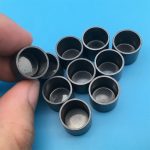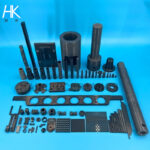Introduction to Zirconia Ceramic Materials
Zirconia, a precision ceramic material with high mechanical strength and fracture toughness, is used in blades, shears, cutting tools, and pump components. Its thermal and chemical stability makes it essential for high-temperature and corrosive environments in aerospace, automotive, and electronics industries.
E-mail:sales01@hkceramic.com

| Plate material mm (L, H, and W can be selected as needed, customization supported) | ||||||||||||
| L | 3 | 5 | 8 | 10 | 12 | 15 | 18 | 20 | 22 | 25 | 28 | More (Customizable) |
| W*H | 100*100 | 90*140 | 95*145 | 150*150 | 160*160 | 122*290 | 110*275 | More (Customizable) | ||||
| Rod material mm (W, Ø can be selected as needed, customization supported) | ||||||||||||
| Ø | 0.5 | 0.8 | 0.9 | 1 | 1.5 | 2 | 2.5 | 3 | 3.5 | 4 | 4.5 | More (Customizable) |
| W | 60 | 100 | 120 | 200 | More (Customizable) | |||||||
Zirconia (Zirconium dioxide, ZrO2) is a highly unique and valuable ceramic material, possessing a variety of remarkable properties.
1. Outstanding Mechanical Performance and Applications
Zirconia (Zirconium dioxide, ZrO2) exhibits superior mechanical characteristics compared to alumina, including higher strength and fracture toughness. These properties make zirconia an ideal choice for many industrial applications, especially in environments requiring materials to withstand extreme forces and wear.
- High Strength and Fracture Toughness: Zirconia surpasses many traditional ceramic materials in strength and toughness, allowing it to remain stable under impact and stress, reducing the risk of fracture.
- Industrial Applications: Due to its high strength and wear resistance, zirconia is commonly used in manufacturing various high-performance industrial components such as parts in milling machines, sliding components, and cutting tool blades. These applications often demand materials capable of withstanding repeated mechanical stress without failure.
2. Excellent Thermal Insulation and Low Thermal Conductivity
Zirconia also boasts excellent thermal insulation properties, with significantly lower thermal conductivity compared to other ceramic materials.
- Low Thermal Conductivity: Zirconia has only one-tenth the thermal conductivity of some other common ceramic materials. This characteristic makes it highly useful in applications requiring insulation or thermal management.
- Thermal Management Applications: For example, in certain chemical processing equipment and high-temperature furnaces, zirconia can be used as a thermal barrier, helping to control temperatures and protect sensitive mechanical components from overheating damage.
| Type | Unit | Zirconia | Zirconia(ZrO2-MgO) | ||
| Material | \ | 94.4% ZrO2-Y2O3 |
94% ZrO2-Y2O3 |
94% ZrO2-Y2O3 |
94.4% ZrO2-MgO |
| Colour | \ | White | Black | Blue | Yellow |
| Density | g/cm3 | 6 | 5.6 | 6 | 5.7 |
| Type | Unit | Zirconia | Zirconia(ZrO2-MgO) | ||
| Material | \ | 94.4% ZrO2-Y2O3 |
94% ZrO2-Y2O3 |
94% ZrO2-Y2O3 |
94.4% ZrO2-MgO |
| Colour | \ | White | Black | Blue | Yellow |
| Flexural Strength(20℃) | Mpa | 800 | 710 | 900 | 500 |
| Compressive Strength(20℃) | Mpa | 2000 | 2000 | 2000 | 2500 |
| Modulus of Elastic(young)(20℃) | Gpa | 200 | 210 | 220 | 250 |
| Tracture Toughness(20℃) | MPam½ | 9 | 8 | 8 | 6 |
| Poi sion’s Ratio(20℃) | \ | 0.3 | 0.3 | 0.3 | |
| Hardness HRA(20℃) | HRA | 88 | 85 | 90 | |
| Vickers Hardness(HV1) | kg/mm2 | 1175 | 1100 | 1220 | 1100 |
| Rockwell Hardness(45N) | R45N | 78 | 75 | 78 | |
| Type | Unit | Zirconia | Zirconia(ZrO2-MgO) | ||
| Material | \ | 94.4% ZrO2-Y2O3 |
94% ZrO2-Y2O3 |
94% ZrO2-Y2O3 |
94.4% ZrO2-MgO |
| Colour | \ | White | Black | Blue | Yellow |
| Thermal Expansion Coefficient | 10-6K-1 | 9.6 | 9.5 | 10 | 10 |
| Thermal Conductivity | W/mk | 2.5 | 3 | 3 | 3 |
| Thermal Shock Resistance | △T.℃ | 250 | 300 | 300 | 450 |
| Specific Heat Capacity | J/g·k | 0.46 | 0.48 | 0.46 | |
| Max working Temperature(In Oxidizing) | ℃ | 800 | 800 | 800 | 2100 |
| Type | Unit | Zirconia | Zirconia(ZrO2-MgO) | ||
| Material | \ | 94.4% ZrO2-Y2O3 |
94% ZrO2-Y2O3 |
94% ZrO2-Y2O3 |
94.4% ZrO2-MgO |
| Colour | \ | White | Black | Blue | Yellow |
| Vol une Resistivity at 20℃ | Ωcm | 1014 | 1010 | 1014 | 1014 |
| Dielectric Strength | KV/mm | 13 | 13 | 13 | 13 |
| Dielectric Constant | \ | 28 | 28 | 28 | 28 |
| Dielectric LossAngle at 20℃,1MHz20℃ | tanδ | 17*10-4 | 17*10-4 | 17*10-4 | 17*10-4 |
*For more details, please feel free to contact our company.

Small Silicon Carbide Ceramic Crucible
Material:Silicon Carbide Ceramics
Describe:Custom small silicon carbide (SiC) ceramic crucibles offer stability and durability at high temperatures, ideal for reliable experiments and production.

High Temperature Resistant Alumina Ceramic Insulation Ring
Material:Alumina ceramics
Describe:High Temperature Resistant Alumina Ceramic Insulation Ring, also known as porous retaining rings, feature precise designs with drilled holes for secure connection. Their high hardness and strength ensure stability and durability under pressure, ideal for long-lasting equipment performance.

High Temperature Silicon Nitride Ceramics
Material:Silicon Nitride Ceramics
Describe:Our silicon nitride ceramic sealing rings are made of 99% high-purity Si₃N₄ material and are formed by hot pressing and sintering. They have super corrosion resistance (resistance to HF acid and molten aluminum) and high temperature resistance (continuous operation at 1200°C). They have a 50% longer service life than traditional silicon carbide sealing rings and are widely used in chemical...

Macor Ceramic Ferrule/Bush
Material:Macor Ceramic
Describe:Machinable ceramic Bush are a type of advanced ceramic material with excellent machining properties. They can be cut, drilled, milled, etc. on conventional machining equipment (such as CNC, lathes, and drilling machines) without the need for special diamond tools. They are widely used in precision electronics, semiconductors, medical and high-temperature insulation fields.

High Thermal Conductivity Alumina Ceramic Substrate
Material:Alumina ceramics
Describe:High Thermal Conductivity Alumina Ceramic Substrate, also known as porous retaining rings, feature precise designs with drilled holes for secure connection. Their high hardness and strength ensure stability and durability under pressure, ideal for long-lasting equipment performance.

Aluminum Nitride Precision Ceramic Accessories
Material:Aluminum Nitride Ceramics
Describe:Aluminum Nitride Precision Ceramic Accessories offer precise perforation for mechanical support, electrical insulation, and thermal management enhancement in precision applications.

